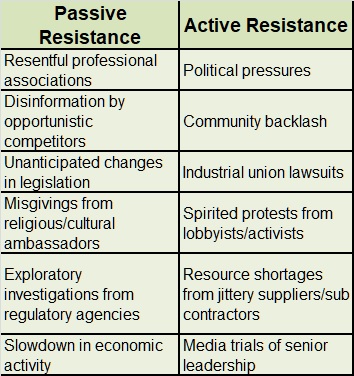Meaningful organizational change is the result of an optimum mix of several factors. Some of them are internal and largely controllable, whereas, others are external and primarily uncontrollable due to their susceptibility to outside influences.
The desire to elevate an organization to a preferred level has the nobility of purpose which demands replenishment with fresh ideas. Consequently, the Change Equation deserves another look at being adjusted for further robustness as a facilitative tool in countering the high incidences of failure rates in organizations trying to attain their change objectives.
Following is the original Change Equation, also known as Gleicher’s Formula, created by David Gleicher and promulgated by Richard Beckhard:
- C = A*B*D > X
- C = Successful change
- A = Status quo dissatisfaction
- B = Desired clear state
- D = Practical steps to the desired state
- X = Cost of the change
The original Change Equation was refined by Kathie Dannemiller as follows:
- C = D*V*F > R
- C = Successful change
- D = Status quo dissatisfaction
- V = Vision of what is possible
- F = Initial concrete steps taken to achieve vision
- R = Resistance to change
Following is the modified Change Equation proposed by me:
- C = A*I*R*CLAP > IC + EC
- C = Successful change
- A = Aligned realization for change
- I = Insightful visualization of desired state
- R = Robust methodology for enabling change
- CLAP = Conscientious learning and application propensity
- IC = Internal challenges to change
- EC = External challenges to change
Let’s explore the various elements of my version of the equation.
Aligned realization for change (A)
This refers to the pervasiveness of a continuous improvement mindset within the organization. It has to go beyond the reactive temperament of ubiquitous dissatisfaction with the status quo as a primary driver for change. Such an impetus requires a proactive disposition that derives its strength from Frederick Herzberg’s Motivation-Hygiene Theory that postulates the principle that an absence of dissatisfaction doesn’t equal satisfaction. Therefore, the case for creating an “urgency to change” should be based upon an unrelenting organizational desire to excel, regardless of the status quo nullifying the notion “If it ain’t broke, don’t fix it” and embodying a disruptive approach.
Insightful visualization of desired state (I)
This refers to stepping away from the temptation of defining an idealistic vision that projects a mirage rationale for embarking upon doomed initiatives. It requires due diligence of an organization’s capabilities with respect to the mobilizable resources, availability of prodigious talent and prevalence of favorable factors for business in the foreseeable future. It demands an enlightened leadership that is cognizant of organizational strengths and has the humility to accept shortcomings with an attitude that incentivizes progressive behaviors. It is manifested in the form of a map, easily understood and fervently supported by key stakeholders, of the desired possibilities that reflect a realizable state of significantly elevated achievements within an acceptable margin of error.
Robust methodology for enabling change (R)
This refers to the incisive and systematic approach to managing change with associated risks through clearly delineated steps, by either deploying a proven model by prominent thought leaders/practitioners, e.g., Kurt Lewin, John Kotter, Jeff Hiatt, etc., or developing a customized version with the specific organizational dynamics. It should exhibit the resistive capabilities of Teflon, in terms of deflecting all forms of passive and active resistance. It should be well understood by its proponents and have the osmotic ability to seep into the organizational culture as a key enabler of excellence. It should have the longevity to outlast “fad-surfing” and be able to successfully resist the visible and subtler attacks from forces vying to plot, program and pronounce its failure.
Conscientious learning and application propensity (CLAP)
This refers to the collective set of vibrant employee behaviors that symbolize the proclivity to achieving successful change and are the extrinsic manifestations of an integrity-driven demeanor that harnesses positive attitudes with the requisite knowledge, skills and competencies to achieve desired goals. The tendency to bring about meaningful change is an intrinsic characteristic that varies in its intensity from one employee. Consequently, it has more weight over leadership dictates that are disguised as organizational solidarity through a publicized buy-in by accommodating employees fearful of backlash from the power brokers. A key success factor to watch in this context is the extravagant display of Organizational Citizenship Behaviors (OCBs).
Internal challenges to change (IC)
This refers to the passive and active resistance aspects that pop up within the organization during various stages of the change cycle. They can either be unintentional or intentional in nature, e.g.:

External challenges to change (IC)
This refers to the passive and active resistance aspects that pop up from outside the organization during various stages of the change cycle. They can either be unintentional or intentional in nature, e.g.:

Parting advice
Don’t forget to CLAP your way to success!
